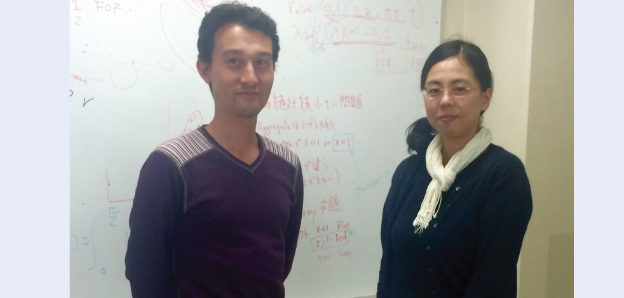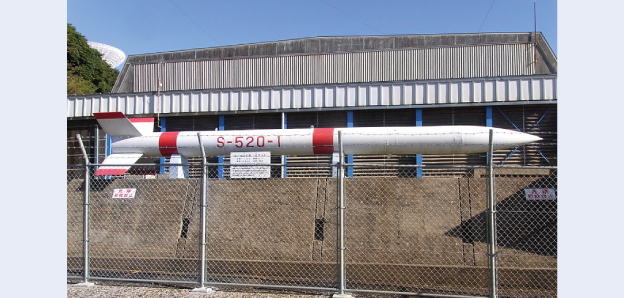Spotlight on Research #22: It’s (literally) Rocket Science
Research Highlight | September 28, 2015
-
 Associate Professor Yuki Kimura (left) and postdoctoral researcher, Dr Kyoko Tanaka.
Associate Professor Yuki Kimura (left) and postdoctoral researcher, Dr Kyoko Tanaka. -
 Full scale model of the S-520 rocket at the JAXA Uchinoura space centre.
Full scale model of the S-520 rocket at the JAXA Uchinoura space centre.
The evening of Friday September 11th rolled in warm and clear above Japan’s Uchinoura Space Centre. The slender rocket sitting on the launch pad was the S-520-30; a scientific research rocket designed to perform experiments in the extremely weak gravity of space.
At 8pm, the rocket launched, gaining over 300km in height to take it to just 100km below the orbit of the International Space Station. Less than a minute after lift-off, an electric current automatically started the on-board experiment as the rocket sailed far above the Earth’s surface. In ten minutes, it was all over in an ocean splash-down, 300km off the coastline.
As their experiment disappeared beneath the waves, Associate Professor Yuki Kimura and Dr. Kyoko Tanaka at Hokudai’s Institute of Low Temperature Science, were triumphant. They now had a measurement for how the first dust particles formed in the universe.
Stars are the factories for our chemical elements. By fusing together lighter atoms in their core, everything from helium through to oxygen, nitrogen and iron is manufactured. As the star dies, these elements are thrown outwards to cool around their dying parent. In the same way water condenses into ice, the vaporous elements become solid particles of dust.
The role of dust in our universe is hard to underestimate. Suspended in the cold gas clouds that birth the next generation of stars, dust provides a surface for more complex chemistry, including the formation of the first organic molecules needed for life. It also heats the galaxy by warming in the ultraviolet light from the stars and when condensing around young stars, it marks the beginning of the planet formation process.
Yet how did the first dust form and why is a rocket needed to find out?
In a laboratory, temperatures can be raised to mimic the conditions around a dying star. Yet, both the experiment container and gravity are a big problem. As the gas is heated, gravity creates a convection cycle where hot gas rises to cool, sink and be reheated. This regular motion prevents the gas being evenly distributed through the experiment chamber, instead producing uniform clumps that make it easier for very similar kinds of dust particles to form. Moreover, the easiest way for a vapour to change into a solid is on a surface. Like mist condensing into ice crystals on a cold windowpane, the edge of the container forms the perfect site for dust grain production. The result is the creation of dust under very different conditions from those around a star.
What Yuki and Kyoko needed was a way to form dust without gravity or a surface. Using a rocket pulled the experiment out of the Earth’s gravity, removing the problem with convection. To deal with the container wall, the scientists filled the chamber with argon gas. Argon is described as a ‘noble’ or ‘inert’ gas, as it is very reluctant to undergo any chemical reactions. Instead, the vaporised elements bounce off the argon atoms to increase the time it takes to reach the container wall. By the time any non-argon atoms do reach the container surface, they have already cooled to form dust.
The rocket experiment this month tested the formation of aluminium and silicon oxide dust. The molecules were evaporated as the electric current heated the wires inside the experiment container. The vapour then began to cool and form dust. This left the challenge of detecting when the solid particles began to form.
Dust detection involved using lasers in a technique known as ‘interferometry’. A laser beam is split into two identical light waves, one of which travels through the experiment chamber while the other passes through the vacuum outside. The two beams are reunited the other side of the experiment chamber. While no dust has formed in the experiment, the two laser beams remain identical; they have travelled the same distance and their light waves are completely in sync. However, once dust has formed in the experiment, the laser beam passing through the container is scattered by the solid particles. It therefore travels further than the outside beam and the two waves get out of sync. This mismatch can be measured to tell the scientists exactly when the dust has formed, providing its formation temperature and information about its concentration. From these measurements, Kyoko’s calculations can uncover how efficiently the dust forms and how easily it sticks together to create larger grains.
While Yuki and Kyoko have only just received the data from this experiment, it was not the first time they investigated the dust production process. In 2012, they launched an experiment to measure how iron condenses into dust. The results were very surprising.
In the laboratory in the Department of Natural History Science, Associate Professor Shogo Tachibana found that iron particles stick easily together when there is a surface. However, in the microgravity of space, Yuki and Kyoko found that the probability of iron grains sticking was lower by a whopping factor of 10,000.
“Iron dust nucleation (first condensation into dust) is difficult,” Yuki explains. “But once you have the particle and it provides a surface, growing is much easier. Shogo’s experiments show this.”
This explains why the dust around dying stars rarely contains a lot of iron; the first grains are very difficult to form.
Such results tell scientists about the dust surfaces present in interstellar gas. These are details that affect what reactions will occur on these new particles. It is a process that changes the observation and production of stars through to the creation of life’s elements themselves.
—
Want to hear more about research at Hokudai?
Hokkaido University is hosting a TEDx event on October 11th!
(Applications for student audience members now open)
—
Author: Elizabeth Tasker
